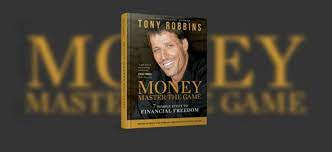Book Summary

Money: Master the Game” by Tony Robbins is a comprehensive guide to personal finance and investment. Published in 2014, the book draws on interviews with some of the world’s most successful investors and aims to demystify the complex world of financial investment for the average person. Here’s a summary of its key points:
- The Importance of Financial Freedom: Robbins emphasizes the significance of achieving financial freedom and the role it plays in overall life satisfaction.
- Seven Simple Steps to Financial Freedom: The book outlines seven steps designed to help readers take control of their financial future. These include making the decision to become an investor rather than a consumer, knowing the rules of the game, and understanding risk management.
- The Power of Compound Interest: Robbins highlights the importance of compound interest and starting to save and invest early.
- Asset Allocation: The book stresses the importance of asset allocation and how diversifying your investment portfolio can minimize risk.
- Understanding Fees: Robbins points out how high fees can erode investment returns over time and advises readers on how to choose investments with lower fee structures.
- Psychology of Investing: Robbins delves into the psychological aspects of investing, including the common emotional pitfalls and how to avoid them.
- Learning from the Best: The book includes insights and advice from several financial experts and billionaires, like Ray Dalio and Warren Buffett, providing readers with strategies and principles used by some of the most successful investors.
- Creating a Lifetime Income Plan: Robbins discusses the importance of creating a sustainable income plan for retirement.
- Giving Back: The final step focuses on the importance of philanthropy and using financial success to make a positive impact on the lives of others.
Robbins’ book is praised for its actionable advice and simple explanations of complex financial concepts, making it accessible to a wide range of readers, regardless of their financial literacy level. It’s a mix of motivational content, practical finance tips, and insights from some of the world’s most successful financial minds.
What are the seven steps?
Here’s a summary of these steps:
- Make the Most Important Financial Decision of Your Life: Commit to setting aside a portion of your income for investment. Robbins suggests saving and investing even a small percentage consistently over time can lead to substantial wealth.
- Become an Insider – Know the Rules Before You Get in the Game: Understand how the financial market works. Educate yourself about the impact of fees, the importance of tax efficiency, and how to avoid common investment mistakes.
- Make the Game Winnable: Define clear financial goals. Determine what amount of money you need for financial security and independence.
- The Asset Allocation: Learn about different asset classes and their roles in wealth building and protection. This step involves creating a balanced investment portfolio that aligns with your risk tolerance and financial goals.
- Create a Lifetime Income Plan: This step involves understanding various investment strategies for generating income, particularly during retirement. It’s about ensuring a steady income stream that lasts throughout your life.
- Invest Like the .001%: This step covers learning investment strategies from some of the world’s most successful investors. Robbins shares insights gleaned from interviews with top financial experts.
- Just Do It, Enjoy It, and Share It: The final step emphasizes taking action on your plan, enjoying the process and the fruits of your labor, and giving back to society.
How to invest like the 0.01%?
- Studying the investment strategies and philosophies of successful investors.
- Understanding the importance of minimizing loss through smart investment choices.
- Learning how top investors diversify their portfolios and manage risk.
Here are some key takeaways:
- Diversification: This is a fundamental principle used by successful investors. Diversification isn’t just about having different stocks; it’s about spreading your investments across various asset classes (like stocks, bonds, real estate) and even within each class. This strategy helps in managing risk and reducing the impact of any single investment’s poor performance.
- Risk Management: Top investors are keen on managing risk. They employ strategies like asset allocation and diversification to mitigate risk. Some use more sophisticated methods like hedging and alternative investments (like commodities or private equity) to protect their portfolios.
- Understanding Market Trends: Successful investors have a deep understanding of market trends and economic indicators. They often use this knowledge to make informed decisions, rather than reacting to short-term market movements.
- Long-Term Perspective: Many of the world’s most successful investors take a long-term view on their investments. They are not swayed by short-term market fluctuations and focus on long-term growth and sustainability.
- The Power of Compound Interest: The best investors understand the power of compound interest and start investing as early as possible. They know that time is an essential element in growing wealth.
- Avoiding High Fees: Savvy investors understand how fees can eat into returns. They often prefer low-cost index funds or ETFs (Exchange Traded Funds) to actively managed funds with higher fees.
- Value Investing: Some of the most successful investors, like Warren Buffett, are known for their value investing strategy. This involves finding undervalued companies that have strong fundamentals and holding onto these investments for a long time.
- Psychology of Investing: Understanding the psychological aspects of investing, such as not being driven by fear or greed, is a common trait among top investors. They tend to be disciplined and not swayed by emotions.
- Continuous Learning and Adaptation: The investment world is constantly changing, and successful investors commit themselves to lifelong learning and adapt their strategies accordingly.
- Giving Back: Many successful investors also believe in using their wealth for social good. This philanthropic approach not only contributes to society but can also be fulfilling on a personal level.
Robbins emphasizes that while these strategies are used by the ultra-wealthy, they can be adapted and applied by anyone. It’s about understanding the principles that drive successful investment decisions and applying them consistently over time.
What’s a lifetime income plan?
- Understanding the importance of and planning for retirement income that covers all your basic expenses.
- Exploring different investment vehicles that can provide a stable income in retirement, like annuities or dividend-yielding stocks.
- Focusing on creating a portfolio that aims to deliver consistent returns, taking into account factors like inflation and changing personal circumstances.
Buy the book!
The book is a great book with some important lessons. You can buy it here.
